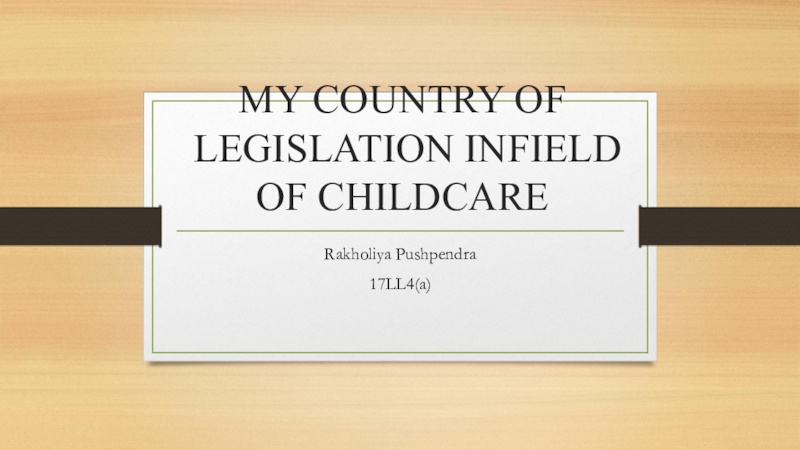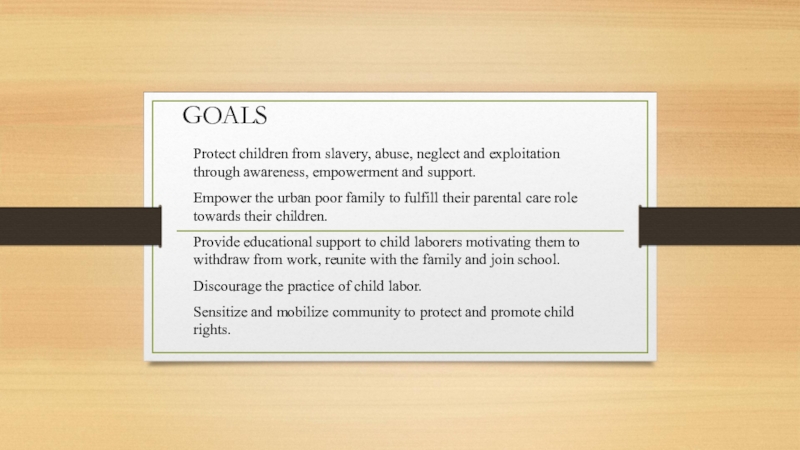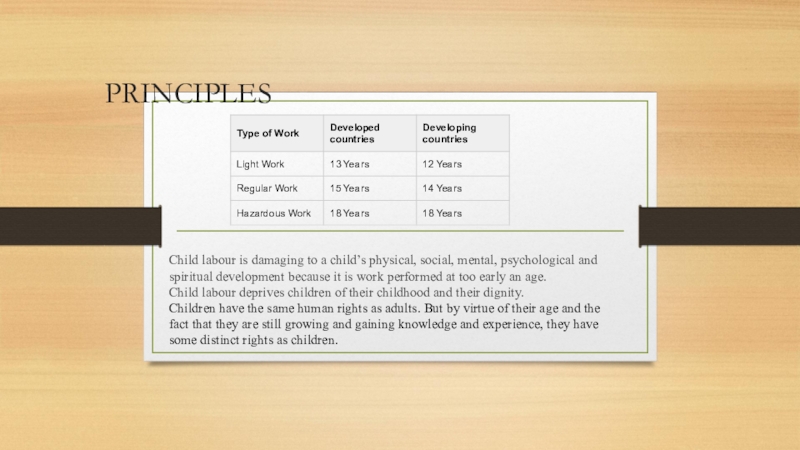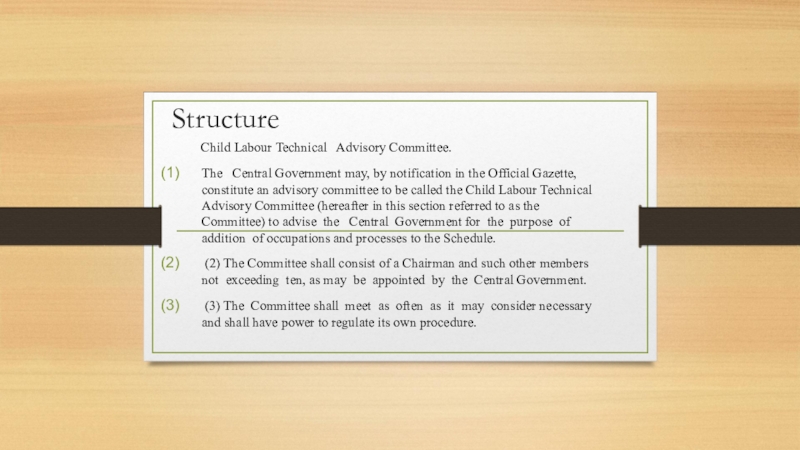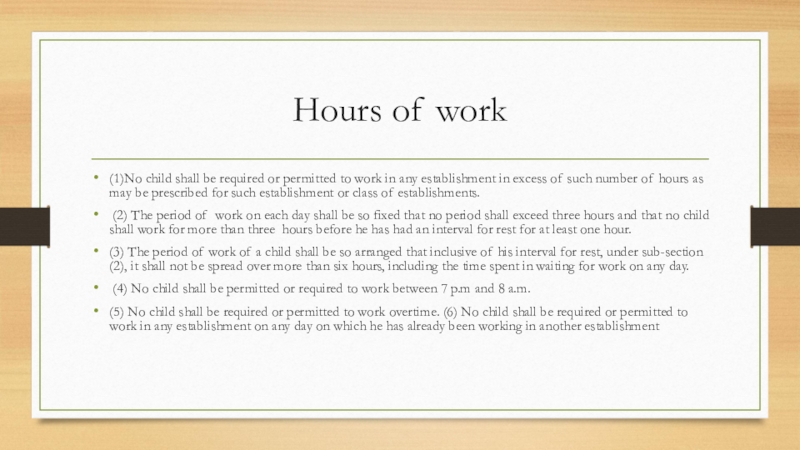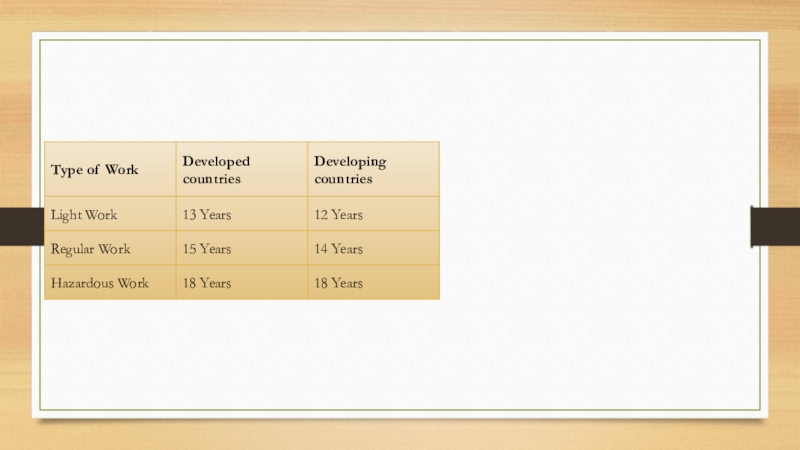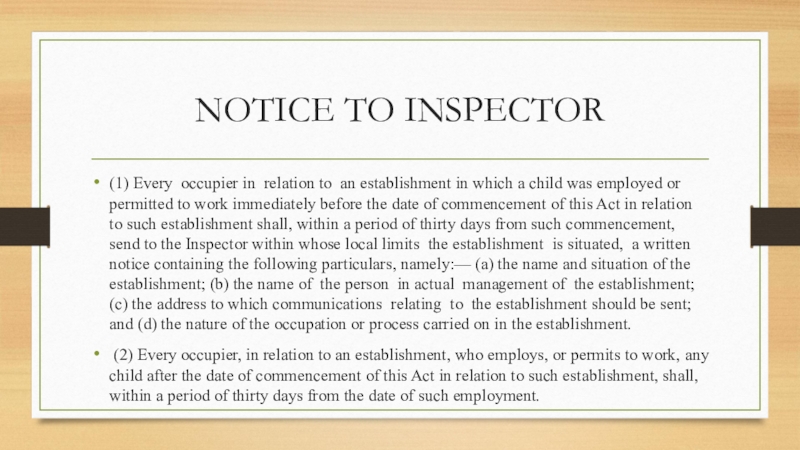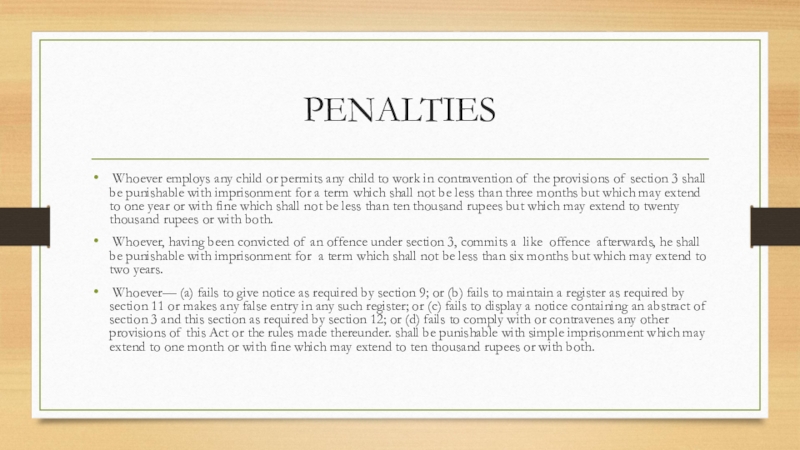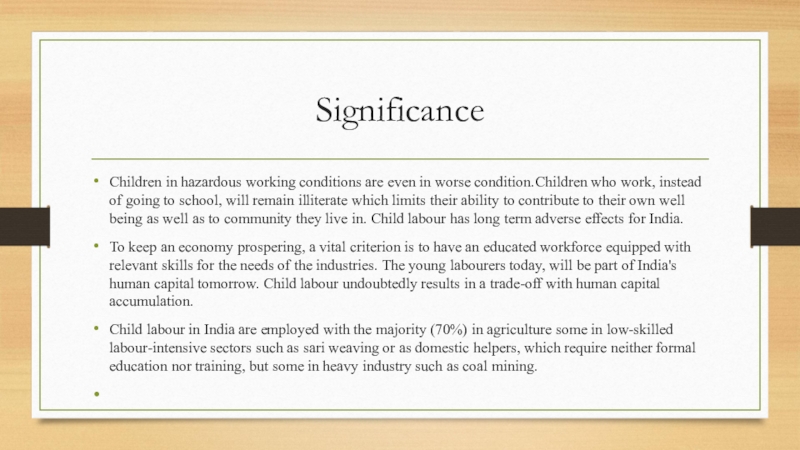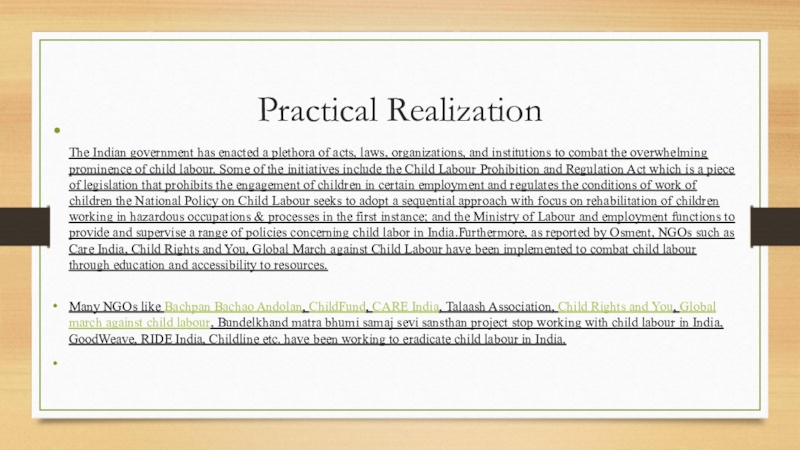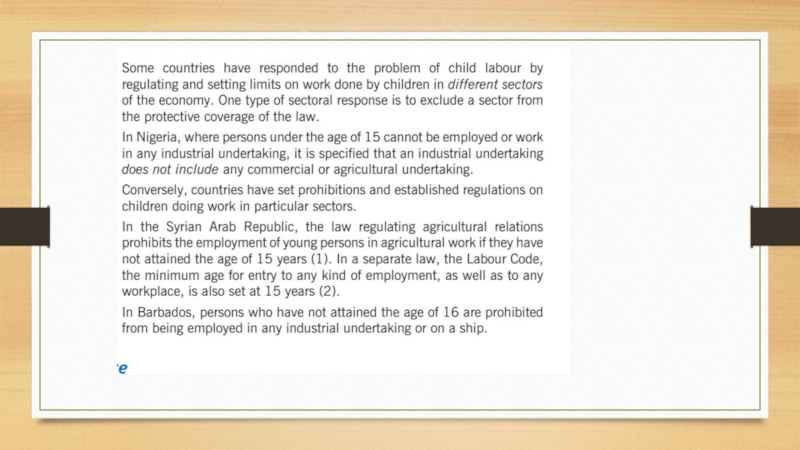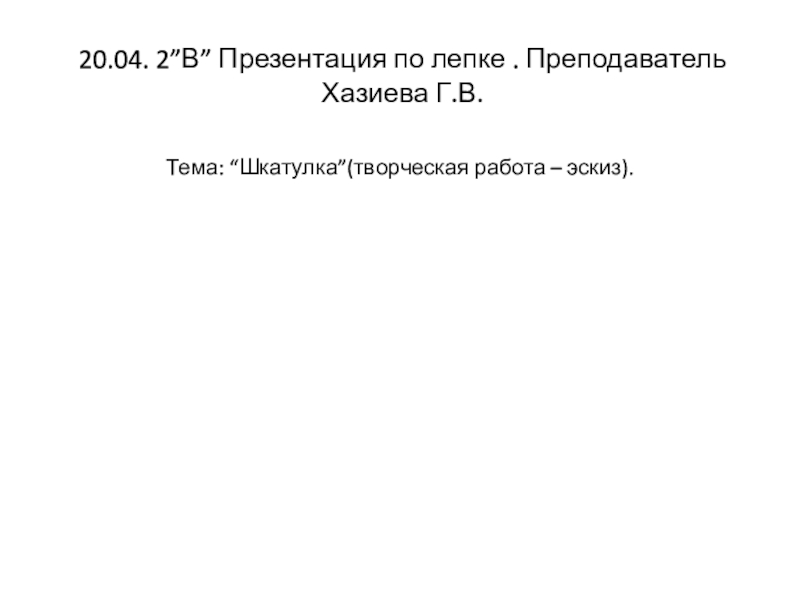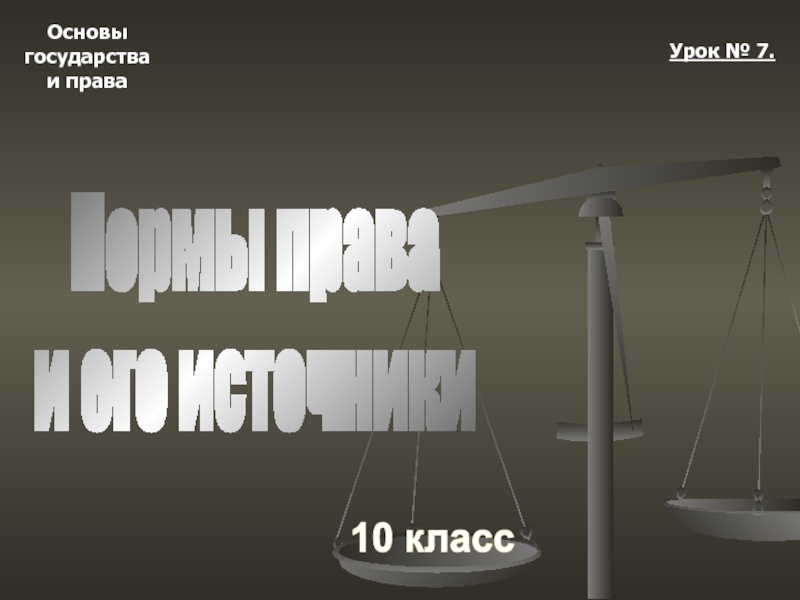Разделы презентаций
- Разное
- Английский язык
- Астрономия
- Алгебра
- Биология
- География
- Геометрия
- Детские презентации
- Информатика
- История
- Литература
- Математика
- Медицина
- Менеджмент
- Музыка
- МХК
- Немецкий язык
- ОБЖ
- Обществознание
- Окружающий мир
- Педагогика
- Русский язык
- Технология
- Физика
- Философия
- Химия
- Шаблоны, картинки для презентаций
- Экология
- Экономика
- Юриспруденция
MY COUNTRY OF LEGISLATION INFIELD OF CHILDCARE
Содержание
- 1. MY COUNTRY OF LEGISLATION INFIELD OF CHILDCARE
- 2. CHILD LABOUR ACTThe Child Labour (Prohibition & Regulation) Act
- 3. GOALSProtect children from slavery, abuse, neglect and
- 4. PRINCIPLESChild labour is damaging to a child’s
- 5. Structure Child Labour Technical
- 6. Hours of work(1)No child shall be required
- 7. Слайд 7
- 8. NOTICE TO INSPECTOR(1) Every occupier in relation
- 9. PENALTIES Whoever employs any child or permits
- 10. SignificanceChildren in hazardous working conditions are even
- 11. Practical Realization The Indian government has enacted
- 12. Слайд 12
- 13. THANK YOU
- 14. Скачать презентанцию
CHILD LABOUR ACTThe Child Labour (Prohibition & Regulation) Act (CLPR Act) 1986 prohibits employment of a child in 18 occupations and 65 processes and regulates the conditions of working of children in other occupations. As per this
Слайды и текст этой презентации
Слайд 3GOALS
Protect children from slavery, abuse, neglect and exploitation through awareness,
empowerment and support.
Empower the urban poor family to fulfill their
parental care role towards their children.Provide educational support to child laborers motivating them to withdraw from work, reunite with the family and join school.
Discourage the practice of child labor.
Sensitize and mobilize community to protect and promote child rights.
Слайд 4PRINCIPLES
Child labour is damaging to a child’s physical, social, mental,
psychological and spiritual development because it is work performed at
too early an age.Child labour deprives children of their childhood and their dignity.
Children have the same human rights as adults. But by virtue of their age and the fact that they are still growing and gaining knowledge and experience, they have some distinct rights as children.
Слайд 5Structure
Child Labour Technical Advisory Committee.
The
Central Government may, by notification in the Official Gazette,
constitute an advisory committee to be called the Child Labour Technical Advisory Committee (hereafter in this section referred to as the Committee) to advise the Central Government for the purpose of addition of occupations and processes to the Schedule.(2) The Committee shall consist of a Chairman and such other members not exceeding ten, as may be appointed by the Central Government.
(3) The Committee shall meet as often as it may consider necessary and shall have power to regulate its own procedure.
Слайд 6Hours of work
(1)No child shall be required or permitted to
work in any establishment in excess of such number of
hours as may be prescribed for such establishment or class of establishments.(2) The period of work on each day shall be so fixed that no period shall exceed three hours and that no child shall work for more than three hours before he has had an interval for rest for at least one hour.
(3) The period of work of a child shall be so arranged that inclusive of his interval for rest, under sub-section (2), it shall not be spread over more than six hours, including the time spent in waiting for work on any day.
(4) No child shall be permitted or required to work between 7 p.m and 8 a.m.
(5) No child shall be required or permitted to work overtime. (6) No child shall be required or permitted to work in any establishment on any day on which he has already been working in another establishment
Слайд 8NOTICE TO INSPECTOR
(1) Every occupier in relation to an establishment
in which a child was employed or permitted to work
immediately before the date of commencement of this Act in relation to such establishment shall, within a period of thirty days from such commencement, send to the Inspector within whose local limits the establishment is situated, a written notice containing the following particulars, namely:— (a) the name and situation of the establishment; (b) the name of the person in actual management of the establishment; (c) the address to which communications relating to the establishment should be sent; and (d) the nature of the occupation or process carried on in the establishment.(2) Every occupier, in relation to an establishment, who employs, or permits to work, any child after the date of commencement of this Act in relation to such establishment, shall, within a period of thirty days from the date of such employment.
Слайд 9PENALTIES
Whoever employs any child or permits any child to
work in contravention of the provisions of section 3 shall
be punishable with imprisonment for a term which shall not be less than three months but which may extend to one year or with fine which shall not be less than ten thousand rupees but which may extend to twenty thousand rupees or with both.Whoever, having been convicted of an offence under section 3, commits a like offence afterwards, he shall be punishable with imprisonment for a term which shall not be less than six months but which may extend to two years.
Whoever— (a) fails to give notice as required by section 9; or (b) fails to maintain a register as required by section 11 or makes any false entry in any such register; or (c) fails to display a notice containing an abstract of section 3 and this section as required by section 12; or (d) fails to comply with or contravenes any other provisions of this Act or the rules made thereunder. shall be punishable with simple imprisonment which may extend to one month or with fine which may extend to ten thousand rupees or with both.
Слайд 10Significance
Children in hazardous working conditions are even in worse condition.Children
who work, instead of going to school, will remain illiterate
which limits their ability to contribute to their own well being as well as to community they live in. Child labour has long term adverse effects for India.To keep an economy prospering, a vital criterion is to have an educated workforce equipped with relevant skills for the needs of the industries. The young labourers today, will be part of India's human capital tomorrow. Child labour undoubtedly results in a trade-off with human capital accumulation.
Child labour in India are employed with the majority (70%) in agriculture some in low-skilled labour-intensive sectors such as sari weaving or as domestic helpers, which require neither formal education nor training, but some in heavy industry such as coal mining.
Слайд 11Practical Realization
The Indian government has enacted a plethora of acts,
laws, organizations, and institutions to combat the overwhelming prominence of
child labour. Some of the initiatives include the Child Labour Prohibition and Regulation Act which is a piece of legislation that prohibits the engagement of children in certain employment and regulates the conditions of work of children the National Policy on Child Labour seeks to adopt a sequential approach with focus on rehabilitation of children working in hazardous occupations & processes in the first instance; and the Ministry of Labour and employment functions to provide and supervise a range of policies concerning child labor in India.Furthermore, as reported by Osment, NGOs such as Care India, Child Rights and You, Global March against Child Labour have been implemented to combat child labour through education and accessibility to resources.Many NGOs like Bachpan Bachao Andolan, ChildFund, CARE India, Talaash Association, Child Rights and You, Global march against child labour, Bundelkhand matra bhumi samaj sevi sansthan project stop working with child labour in India, GoodWeave, RIDE India, Childline etc. have been working to eradicate child labour in India.
